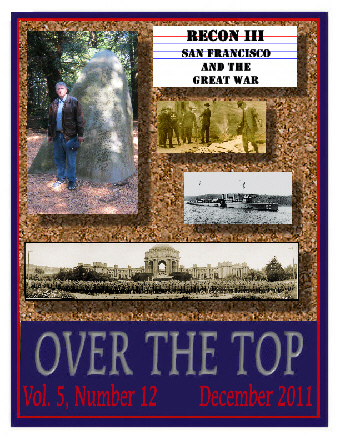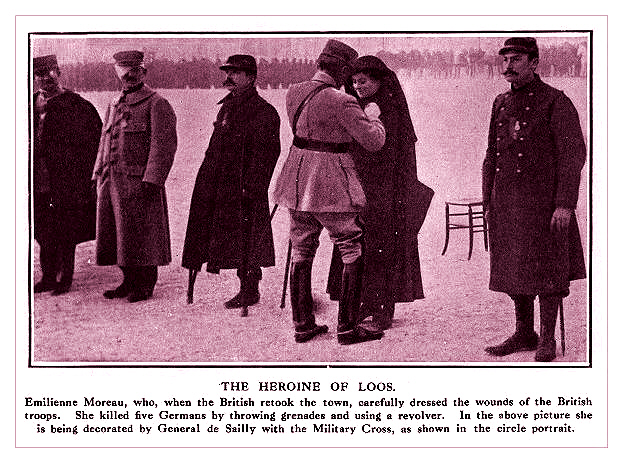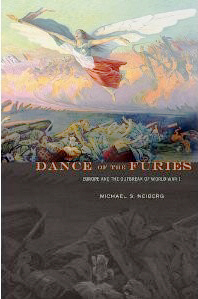


|
TRENCH REPORT: Thanks to all of you who have subscribed to our full-color magazine OVER THE TOP or our annual CDs. If you haven't heard of the magazine yet, there is information below with links for downloading our flyer. . .Another "Recruiting Drive" is underway, the new organization, the World War One Historical Association, formed out of the unification of the Western Front Association's U.S. Branch and The Great War Society, is now signing up new members and renewals at this web page: ww1ha.org/registration.htm. . .Every year at this time, naturally, we like to remember the humanity of the Christmas Truce of 1914. Visit our page on the truce to learn more. (link). Merry Christmas to all. MH
New at Our Own & Our Friends' Great War Websites
Click on Title or Icon to Access
|
News About the Organizational Website(s)
All the former websites of the WFA-USA and TGWS are being consolidated at the new site of the World War One Historical Association where you can download a mail-in membership registration form:
ww1ha.org.
We have implemented a PayPal registration feature for those who wish to pay online. The larger consolidation process will take several months, but all critical information will always be accessible at their new addresses (URLs). For those pages being moved to the new site we will also provide email contacts for those who may have questions. Below is a list of our scheduled activities with contacts:
|
San Francisco Bay Area Chapters (website)
The Bay Area three chapters have meeting on one or more Saturdays every month. See the schedule on the above website or contact Sal Compagno at:
email: sal00@mindspring.com
New England/New York Chapter Seminar (website)
New England Air Museum
Windsor Locks, CT - 10 March 2012
Contact: Guy Cavallaro
email: Ph1m2h3@aol.com
tel: 845-485-8217
Florida-Gulf Chapter Seminar (website)
War on the Eastern Front
Tampa: 16-17 March 2012
Contact: Len Shurtleff
email: lshurtleff@aol.com
tel: 352-379-3200
WW1HA National Seminar
USMC University, Quantico
7-8 Sept. 2012
Contact: Len Shurtleff
email: lshurtleff@aol.com
tel: 352-379-3200
|

One Hundred Years Ago:
Readers may recall that in last month's issue of the Trip-Wire we reported the first dropping of bombs from an aircraft in history was accomplished by an Italian aircraft in the Libyan war in November 1911. In response, the first systematic antiaircraft fire was initiated by Turkish forces in December 1911.
|
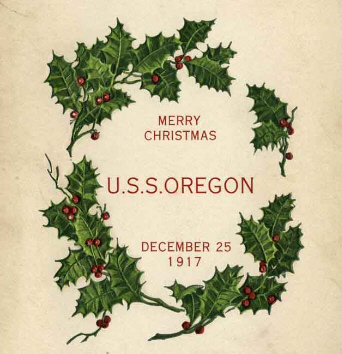
Christmas Menu Cover for the battleship USS Oregon, Which Was Recalled to Active Duty for the Great War
|
GREAT WAR 2011 EVENTS CALENDAR
|
|
We are redesigning our Events Calendar. See left column for World War One Association Activities. Please keep sending us announcements, they will be included when we unveil the new calendar.
|
Send additions/corrections for our 2012 schedule:
Email Response
|
Potatriotic Fever
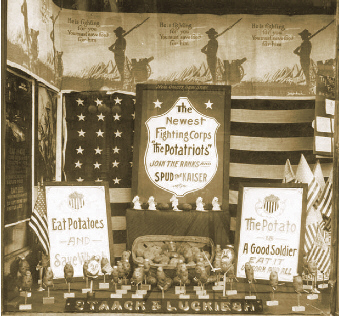
Found in the U.S. National Archives
To help the war effort during First World War, U.S. citizens were encouraged to eat more potatoes while wheat was being sent to the soldiers overseas. This World War I store window display in Iowa showed potatoes dressed as soldiers, encouraging both children and adults to remember the fighting men overseas.
This Month's Internet Feature
War Horses
On Christmas Day Steven Spielberg's World War I epic War Horse is to be released. This month we feature the horses of the Great War.
The Story of the Real War Horses (Great Photos)
The True War Horse
Staging of the Novel War Horse
Horses in World War I
Animals in War Memorial, Hyde Park
"Good bye Old Man" - Heart-Wrenching Illustration by Fortunio Matania

I enjoyed the war, going over the top struck some chord in my nature which vibrated strongly to the thrill of the attack. The War is said to have brought out the beastliest instincts in man. It certainly brought out the noblest self-sacrifice, unselfishness, comradeship.
From Fire-Eater, 1934
Captain A. O. Pollard, V.C.
|
For Your Christmas Stocking
Ghosts, The Great War, 2012 Calendar
|
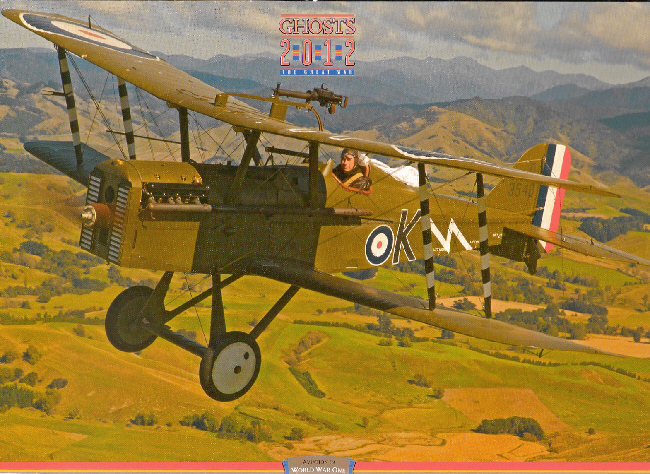
Click on the image to order your calendars, books, posters and computer products from Phil Makanna's Award-Winning Ghosts.
|
|
|
Page Two
|
|
|
The Very First
World War One Historical Association Seminar
|
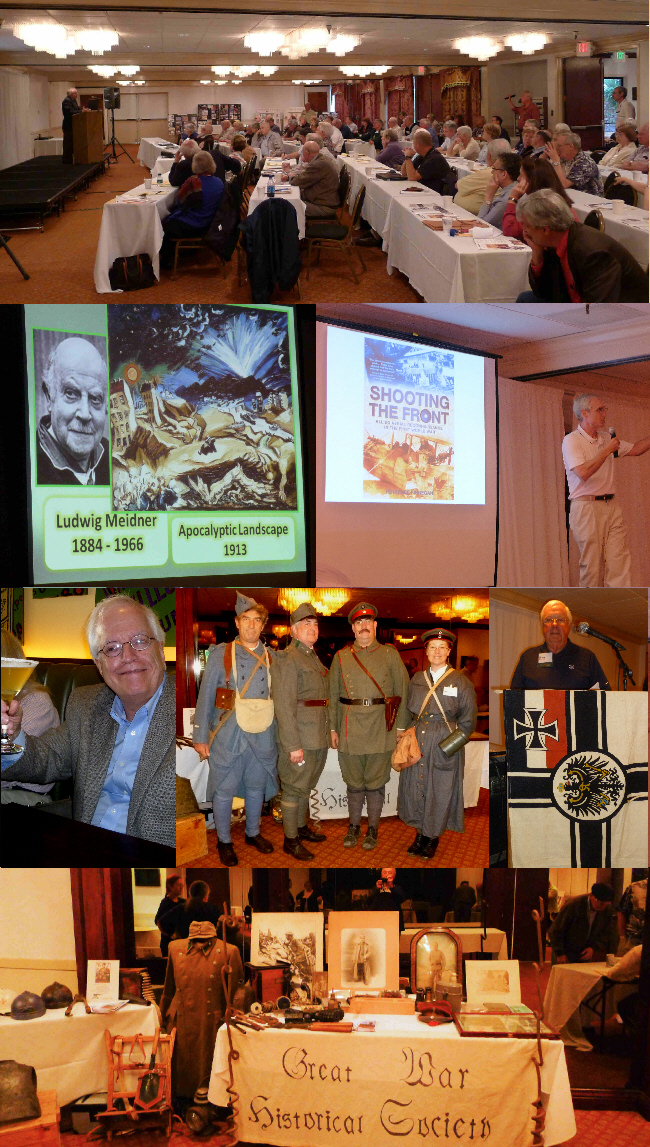
On 9 and 10 September 2011 the newly unified World War One Historical Association held its first national seminar in South San Francisco. "War Art and the Art of War" was a big success. From top to bottom in the event photos above are former WFA-USA President Doran Cart on the National WWI Museum speaking to the group about WWI posters; a slide from Bob Denison's presentation on the art associated with the war; Terry Finnegan alongside a slide from his talk on aerial reconnaissance; George Thompson, who presented on war photography, toasting the event; some of the reenactors who added color to the event and assisted with the delightful period fashion show at the concluding banquet; Dick Church making his presentation on German U-boats; and one of the several informative displays of historical artifacts. In 2012 we meet at the USMC University at Quantico, 7-8 September. (Photos from Herb Stickel and Dick Vandenbruhl.)
|
|
World War I Headlines
in the 21st Century
|
|
|
|
Pilgrimage to Flanders Fields: 2011
Contributed by Kathy Compagno
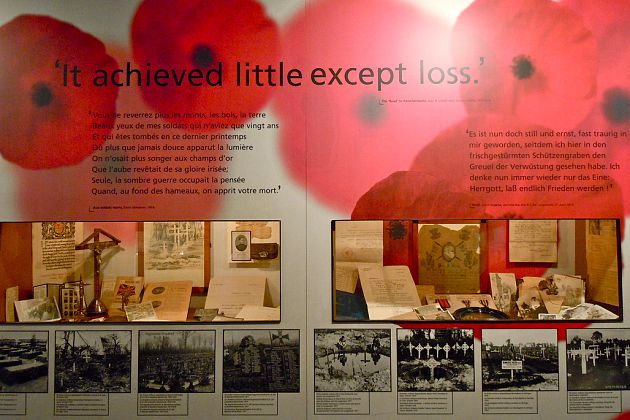
At the Flanders Fields Museum
It was an emotional day for me, visiting the Flanders Fields of Belgium. Every year, on the 11th hour of the 11th day of the 11th month, my Gramps, who served with Pershing's 3rd "Marne" Division, would recite the poem: "In Flanders Fields the poppies blow, Between the crosses row on row" in tribute to the soldiers of WW1 who never came home. These were the battlefields of the early years of the war, before the Americans joined the fight; most are Commonwealth soldiers from Britain and her colleagues. When Gramps arrived with Pershing's American Expeditionary Force, the fighting was mostly on French soil.
Our first stop was at Tyne Cot Cemetery, named for the Tyne River area where so many of the soldiers had come from, and surrounded by a low wall of English flint stones. Row upon row of grave markers, with many simply inscribed "A Soldier of the Great War -- Known Unto God," have a taller wall behind them. The wall contains the names of 35,000 soldiers whose final resting place is unknown, including that of Gunner John Henry "Jack" Wolverson. Sadly, these 35,000 are only a portion of the names of the missing from the Ypres area.
Menin Gate at the edge of town along the Ypres ramparts is where so many WW1 era soldiers watched the battlefields, and where they marched out to join the fray. It was rebuilt as a war memorial "To the Armies of the British Empire who Stood Here from 1914 to 1918", containing the names of 54,000 "of Their Dead Who Have No Known Grave." The names are not in alphabetic order, but listed as regimental groups. I was fortunate to discover the monument registry index in a niche with a bronze door, which led me to the inscribed name of Private Wilfred Saunders Wolverson on Plaque 20, and to tell him he is not forgotten.
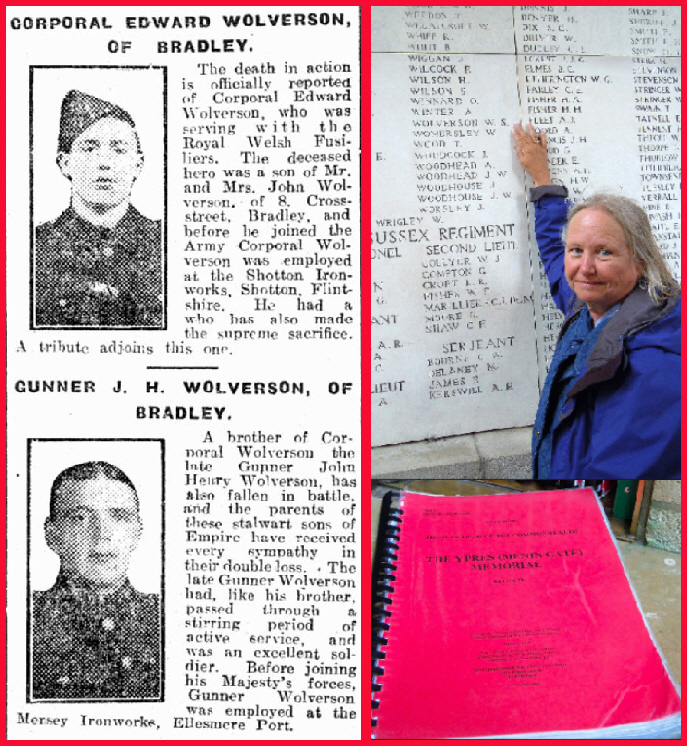
Kathy Compagno (above right) had three distant relatives who died in the Ypres Salient: Edward Wolverson (upper left), who is buried in the Dozinghem Cemetery near Poperinghe, Jack Wolverson (lower left), who is listed with the missing on the walls of Tyne Cot Cemetery, and Wilfred Saunders Wolverson, whose name Kathy is pointing out on the Menin Gate.
Our next visit was to Essex Farm, originally a German fortified bunker which was converted to an Advanced Dressing Station to care for the wounded before sending them to safer hospital areas behind the lines. One of the surgeons here was Canadian Major John McCrae, who was inspired by the sad growing rows of crosses in the neighboring cemetery to write the poem "In Flanders Fields". Our tour guide paused, and read the poem to us; at the end, he had tears in his eyes. The emotion endures a century later. When I looked inside the bunker to see the cold stone walls and floors, which would have been very dark with flickering lights, I thought of my Great-Uncle Joseph Lorenz, wounded in France while crossing the Ourcq River and treated first at a similar American Field Hospital. He suffered further injuries when the field hospital was bombed; the camouflage used at Essex Farm helped me to understand how such unintended damage could occur under saturation bombing.
Our final stop was the In Flanders Fields Museum, located in the rebuilt Cloth Hall in central Ypres. This museum attempts to tell the stories of individuals enduring the wartime years, without a dry recitation of the political and military logistics.
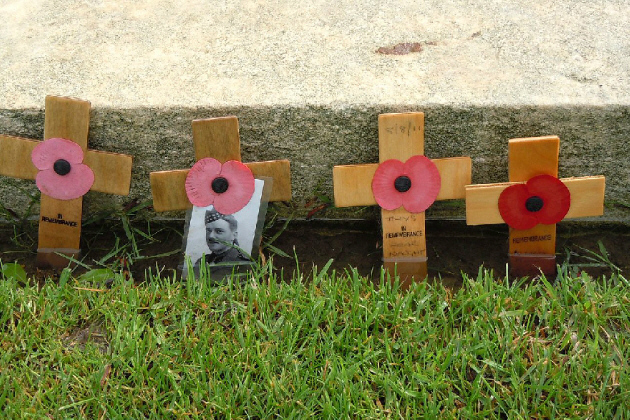
Small, Personal Memorials at Tyne Cot Cemetery
The Battles of Ypres were the worst of trench warfare. What I learned on this trip is that "nothing was left" at the end: towns, villages and farmlands were reduced to muddy fields and rubble. But the people endured, everything we see today has been rebuilt from total destruction. I offer these images in memory of so many who were lost, and in tribute to the resilience of those who survived the war and restored their home.
|
|
|

|
|
Subscribe to Our Online Magazine
|
|

|
|
|
Page Three
|
|
|
Access to In-Depth Articles
From the Royal Air Force
|
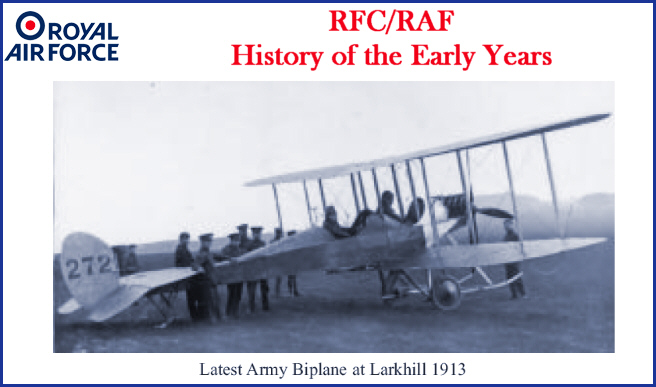
Click on the image to download the 48-page pdf document.
|
Heroic Fort de Liouville
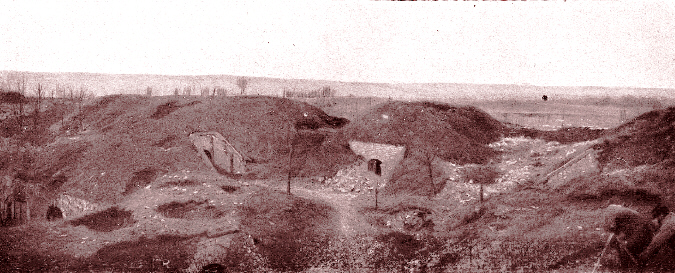
|
Located on a hill between St. Mihiel and Apremont, the French Fort de Liouville held out against a German onslaught in September and October 1914. Despite having every artillery piece destroyed, infantry continued to hold the strategic position for the entire war. This image shows the damage and German shell cratering after the 1914 battles. A preservation group is slowly restoring the fort today.
|
|
|

|
 |
Dance of the Furies:
Europe and the Outbreak of World War I
Reviewed by Len Shurtleff
|
This work is engaging, fluidly written, and constitutes a major contribution to the understanding of World War One. Neiberg rebuts the notion that Europeans were rabid nationalists who went joyfully to war bent on slaughter. The French were not determined to regain Alsace and Lorraine; the growing strength of Socialist parties in both France and Germany militated against war; and the leaders of Hungary vehemently opposed further annexations of Slavic lands. World War One started as a classic "cabinet war" brought out by a handful of men, but quickly degenerated into a "peoples' war."
To make his point, Neiberg posits six central arguments:
There was no exhibition of white-hot nationalism except perhaps among a tiny elite in Germany and Austria-Hungary.
Sophisticated Europeans had many sources of identity besides nationality, including class, gender, ethnicity, and transnational economic, political, and cultural links
Most were convinced that the war, when it came, was defensive in nature; fear of invasion was sufficiently strong to impel societies to wage total war.
The people of Europe, given their presumption of a brief, defensive war responded with determination but not enthusiasm.
Disillusion with the war and the lofty rhetoric governments used to justify it had set in by mid-1915
Societies kept fighting because anything short of total victory after so much suffering and sacrifice was unthinkable.
The first year of war, 1914, was demonstrably the bloodiest. It had become abundantly clear to all involved that the presumptions of August 1914 were unsustainable. The hatreds of 1914-1918 were an effect, not a cause of the war. As the human and material cost mounted the two sides could find no common ground for negotiated settlement.
In reviewing the writings of European, British, and American observers, Neiberg makes clear that most viewed the assassination of Franz Ferdinand as a family tragedy, another assassination in a long succession in recent history, but not a cause for war. Other issues such as the murder trial of Madam Henriette Caillaux, wife of the French Minister of Finance, and the divisive issue of Irish Home Rule dominated the headlines in the weeks following the archduke's murder. Most Europeans, knowing Vienna had no actionable proof of Serbian complicity in the assassination, expected her to demand land or other modest recompense from Belgrade. But, thanks to a handful of determined men in Berlin and Vienna, the machinery of European diplomacy that had defused other recent crises in Morocco, the Balkans, and between Italy and the Ottoman Empire, was not allowed to function, and Europe slipped rapidly into war.
In all, by examining the views of representative Europe, Neiberg finds that war broke out because a select group of perhaps a dozen men willed it or stumbled incompetently into a situation they could not ultimately control. Belligerents continued to fight because they had little choice but to rally to face an existential crisis of survival. War had become a matter of national life or death within its first few weeks. And, when it finally ended, dissatisfaction with the scant rewards of victory and the myths of bitter defeat continued to sour European politics throughout the 1920s and 1930s.
Dance of the Furies: Europe and the Outbreak of World War I, Michael S. Neiberg, Belknap-Harvard, 2011. WFA Tomlinson Book Prize recipient.
|
|
|










